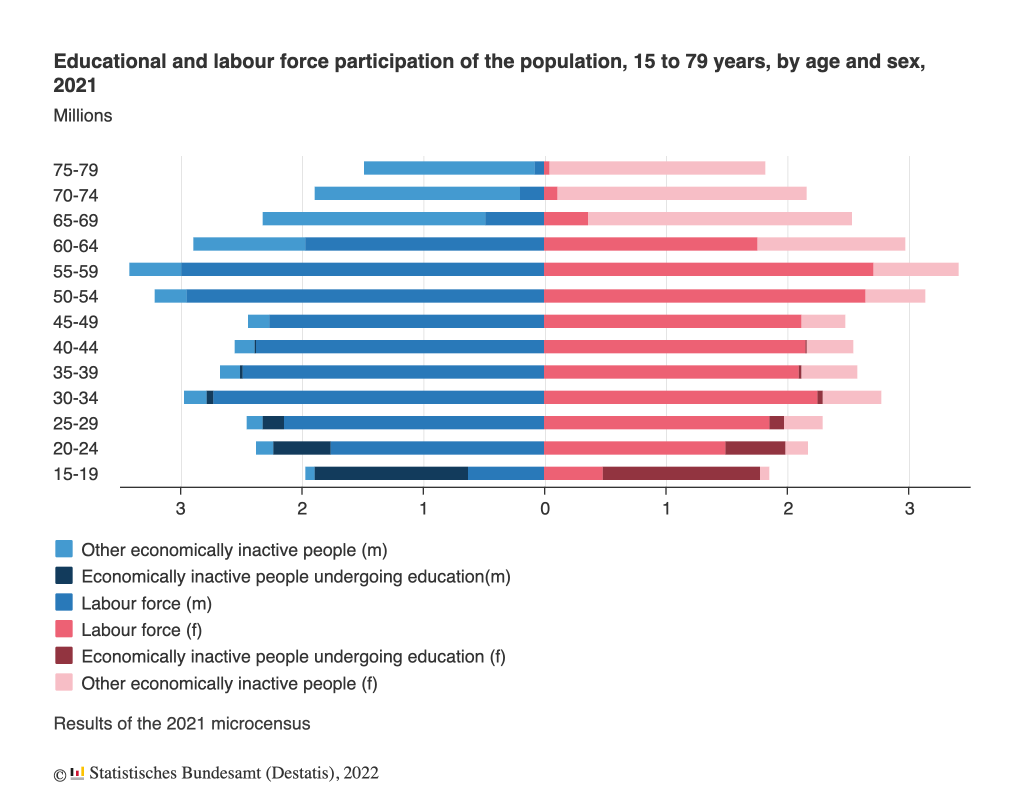How to master the challenges of demographic change
reskilling and upskilling as a solution
In Germany, 12.9 million working people will reach their retirement age by 2036 (Microcensus 2021, Statistisches Bundesamt Destatis). As a result, the labor market will have almost 30% fewer workers than at present.
A comparison shows: In 1950, 100 people of working age were faced with 16 people of retirement age. In 2021, this figure had already risen to 37, meaning that this number has more than doubled.

What impact have these figures on the labor market and our economy? And what opportunities for innovation lie behind them? Here we present you with solutions for mastering the challenges that companies are facing as a result of demographic change.
The consequences of demographic change for companies
The above figures are alarming, especially for companies. This is because they mean that three challenges in particular will have to be mastered in the coming years:
1. Shortage of skilled workers
The already existing shortage of skilled workers will become even more acute. This is because considerably fewer people than before will be available for jobs. It will be difficult to replace the lost workforce and solve necessary tasks at the same time. This shortage of labor brings with it the risk that companies’ ability to innovate will decline because too little manpower will be available.
2. Loss of knowhow
Especially with managers and specialists who retire, the knowledge built up in the company over many years is at risk of being lost. For companies, it is difficult to ensure that the knowhow acquired by long-serving employees is passed on to the next generation in addition to the daily business. The challenge here lies above all in promoting the new ideas and agile methods of the young minds on the one hand and maintaining the proven concepts and processes on the other.
3. Recruiting
The low number of people of working age brings fierce competition for labor. In contrast to the labor market a few years ago, nowadays companies are ‘applying to employees’. Instead of picking the best, recruiters often find themselves in a situation where they are not hiring the “best fit” but are happy to fill the job at all. A US news magazine put it so well some time ago: “The war for talent is over – talent won.”
This brings challenges in terms of time and budget: Due to the rapidly changing job requirements and the often lacking professional experience, new employees need more intensive onboarding phases or have to learn their tasks “on-the-job” first.
In addition to these demographically induced challenges, HR departments and managers are challenged to best realize the wishes of employees with regard to New Work. This is because the imbalance of workers and job offers puts employees in a favorable situation for demands such as job sharing or the 4-day week. These new demands intensify the problem of the shortage of skilled workers, as it is possible these days, that two people will have to be hired for the same (shared) position.
Smart staff deployment thanks to reskilling and upskilling
What can be done now? Given that demographic change is not just around the corner, but that a large number of employees are already retiring, it is too late for tandem education and mentoring. However, reskilling and upskilling is a sustainable way to transform the looming stagnation into an opportunity for more effective and innovative collaboration:
1. Shortage of skilled workers: Evaluation and automation of work tasks
Many of the work tasks currently performed can be digitalized or automated. Although other skills are required for this, companies ultimately save working time and manpower. For a more sensible use of personnel, it is therefore advisable to evaluate current activities and give employees the opportunity to learn the skills of the future. In this way, digitalization and automation can be made possible, leaving more time for innovation.
2. Loss of knowhow: Leadership trainings
A generational change does not only have negative impact at the management level. The mixture of more agile management approaches and proven methods can not only make a job more attractive for applicants, but also advance the company as a whole. To stimulate knowledge sharing, companies need to create supportive settings where different generations can pool their expertise and share learned knowledge. This can be achieved through company-specific training that brings everyone up to the same level and creates a common basis for transformation.
3. Recruiting: Onboarding training
In-depth and company-specific onboarding training is helpful in ensuring that those employees who have been recruited for the company with great effort can also be deployed in an ideal manner.
In this way, young talents who come directly from university and for whom the application of knowledge in practice represents a particular challenge due to a lack of work experience can also be trained in an ideal way.
At the same time, they can be prepared for company-specific activities and create added value in the company productively and effectively from day 1. Particularly in large and multifunctional teams, where the requirements for job profiles also change quickly, onboarding is essential for the smooth integration of new employees and to relieve the burden on the receiving team.
Summary
Challenges
Solutions
- SHORTAGE OF SKILLED WORKERS
- Evaluation and automation of work tasks and company-specific skill development to enable digitalization and automation
- LOSS OF KNOWHOW
- Leadership training for the exchange of knowledge between young talents and long-serving employees in order to jointly drive forward innovations
- RECRUITING
- Onboarding training for company-specific activities, to relieve the burden on the receiving team and to build up competences for employees with a lack of professional experience
Read here what company-specific onboarding training can look like:
OVERVIEW OF A COMPANY-SPECIFIC Onboarding Program


